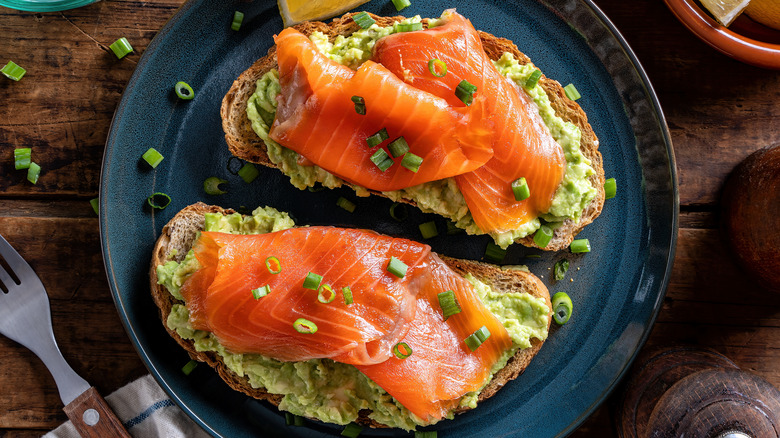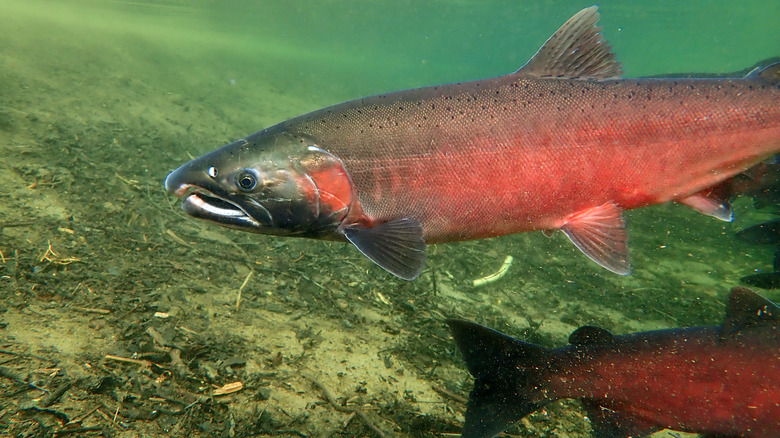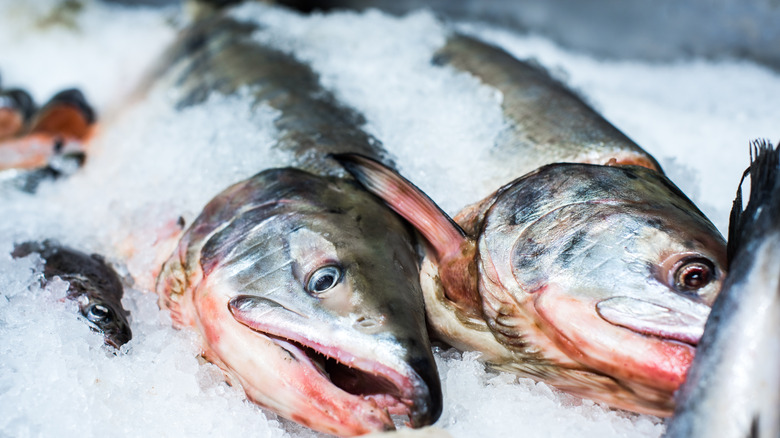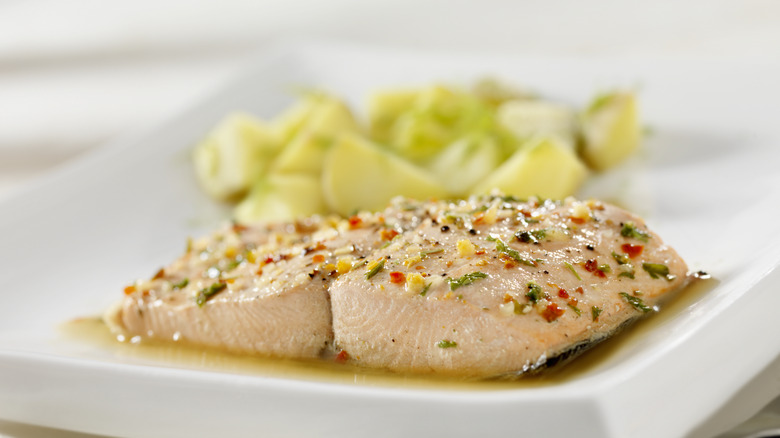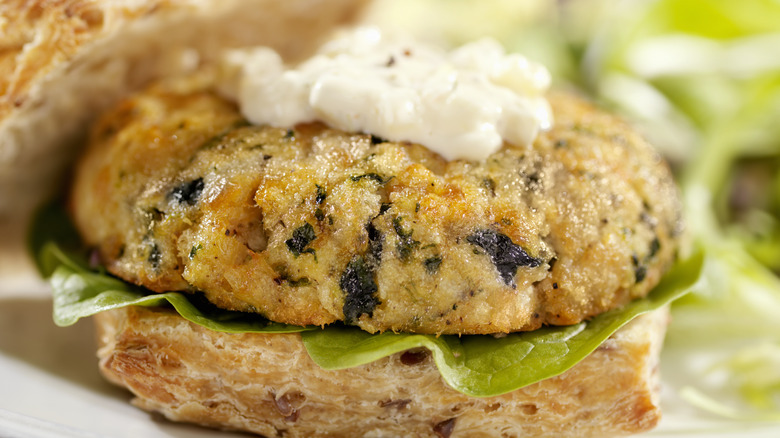The Difference Between Coho And Keta Salmon Is Clear
When it comes to delicious protein options, salmon is always a good call. The fish pairs with a variety of flavors and doesn't require a lot of technical cooking to prepare. As a result, it's easy to choose from an abundance of salmon recipes for any meal. You'll just need to consider several criteria when selecting the fish at the store: how it's cut, as well as the variety.
Shoppers often overlook the nuance of the salmon type. There are seven Pacific species and one Atlantic to choose from, each with a different flavor and appearance. Not all are found in the U.S., but most salmon types do roll out onto American shelves. You may have heard of famous ones like sockeye and king, but there's delicious merit to lesser-known ones like coho and keta, too.
Coho and keta pack in some distinctions, both as live animals and in qualities that translate onto the plate. Coho, with its silver color, is a nomadic variety all across the Pacific. It is low in fat and delicate in its taste, making it one of the most accessible salmon types. Alternatively, keta — which is native to the far north Pacific and Arctic — has historically been best known for its roe, but recently, chefs have been giving its mild flesh greater culinary attention.
What is coho salmon?
Coho salmon inhabit a large swath of the Pacific, covering a range from Japan to Russia and the U.S. During its life cycle in the ocean, the fish has a beautiful silver color, which also signifies it is at its optimal flavor. Whenever the salmon swims into freshwater rivers, it turns more red, evidence it's entering mating season. The fish type typically comes in a small to medium weight, averaging around 10 pounds, but it can reach as much as 24 pounds.
Don't be fooled by the light orange color of coho flesh, which looks less robust than other wild salmon. The flavor is delicate and delicious, making it an especially prized salmon type. It's less fatty and packs in less fishy notes, yet is nonetheless very tender, making it a pleasant textural experience. Such characteristics make it an approachable choice for pickier seafood eaters.
Additionally, this salmon variety is distinguished by its sustainable nature, with a well-regulated harvest, as noted by the National Oceanic and Atmospheric Administration. So, seek it out and add it to your shopping cart as both a delicious and ethical purchase option.
What is keta salmon?
Keta salmon occupy a narrower area found in the colder waters of the North Pacific and Arctic rivers. The fish do occur in the coastal areas of both the U.S. and Japan, making them an intercontinental species. They're similar in size to the coho, found in a range from 8 to 20 pounds. They have a greenish tint, with off-colored patches of red, and a light-colored belly. Keta salmon are also distinguished by their talon-like teeth, which lend them their alternate dog moniker.
Historically, keta salmon hasn't been the most coveted salmon type; hence, other unflattering names like chum. They are more frequently caught for their roe, which comes in a large size and variety. At this stage, the flesh is less flavorful, which is why it's reserved for processed applications like canning.
However, if caught at an optimal seasonal time — said to be the fall in Japan — the fish is delicious. As a result, this salmon variety is starting to see a resurgence and appreciation for its mild flavor. It's a low-fat salmon type with a gentle palate yet firm flesh. Its coloration is less vibrant — among the lightest of all salmon types. Despite its less prized nature, it is one of the most harvested varieties in Alaska. Nevertheless, it's a sustainable salmon type to purchase, according to the National Oceanic and Atmospheric Administration.
Coho salmon's low-fat and delicate flavor require careful cooking
With coho's gentler taste and texture, it necessitates a bit more care when cooking. It's delicious poached — perhaps in olive oil for a pink color — or carefully pan-fried. However, you may not want to put a fillet on the grill since it's best with some additional liquid during cooking.
Whenever sourced fresh, coho yields one of the tastiest sashimis, and it's the perfect candidate for other raw applications like salmon-based poke or crudo. And with smaller exemplars, it also does well whole, especially when smoked. In fact, Native Americans in the Pacific region traditionally employed smoking as a method of preparation.
Coho serves up just enough intrinsic flavor without an overpowering taste, making it one of the best salmon varieties to serve standalone, with an accompaniment like a simple tartar sauce or olive oil-based condiment like a bright and fresh pesto. Combined with its lower price, it's one of the best varieties to purchase for a tasty dinner that comes together quickly.
Amplify keta's flavor with aromatic additions
Keta salmon's meat is lean and mild in taste, which means it tastes best when elevated with additional ingredients. Its dense texture, combined with a lack of fishiness, makes it a great candidate for some salmon cakes or pan-fried salmon croquettes. Alternatively, use it as a foundation for a Tom Kha-inspired salmon and corn chowder.
With its affordable price, keta salmon opens up possibilities for a delicious array of casual recipes. Grill it into a salmon burger alongside basil and scallions, or throw it in a sandwich alongside big flavors like chipotle mayo and bacon. Steaming is another popular method in Japan, providing a great option to amplify keta salmon with additional sauces like soy and sesame oil. With its mild flavor profile, there won't be a clash — in fact, the fish will benefit from flavorful complements. And with its firm texture, keta will hold up to many of the ways to cook salmon. Whether grilled, broiled, or pan-fried, this fish variety brings a casual accessibility to a salmon night.
